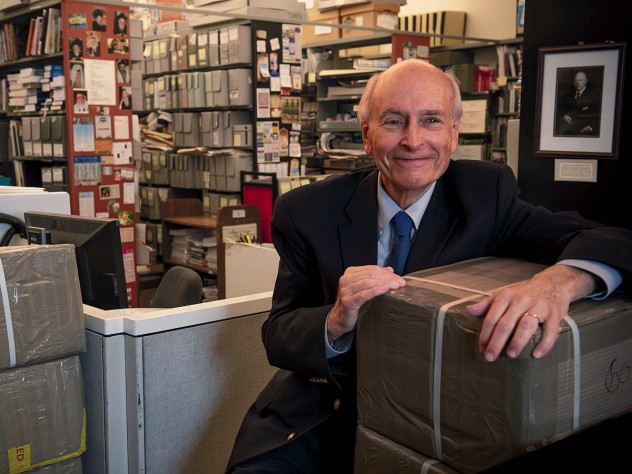Behind the Scenes: Digging into the archive
Associate editor Lydialyle Gibson discovers the vast collection of Harvard Library’s Judaica Division.
When I started working on the September-October feature about Harvard Library’s Judaica Division—and the 86-year-old archivist who has led it for 60 years—I didn’t quite know what to expect. The University has such a vast and expanding universe of specialized archives and research units, and I knew there was a collection of materials covering Jewish life, art, literature, and history, but I did not know many details about it.
I soon learned. Charles Berlin ’58, Ph.D. ’63., now in his sixth decade as head of Harvard’s Judaica Division, and his staff, especially Vardit Samuels and Elizabeth Vernon, gave me a swift education in the division’s history and breadth. I read back issues of its newsletters and browsed the catalog of its digital holdings—photographs, posters, books. I also pored over the bound volume the division staff had published in 2013 to commemorate its fiftieth anniversary the previous year, which gave a detailed account from its Puritan-era beginnings through to the present day, as well as a picture of Berlin’s own arc during the past six decades. Later, I’d speak with a few of the scholars whose research relies on the Judaica Division about their experiences finding primary sources for their work.
But the story really came to life for me when I was able to visit the division’s offices in Widener Library in person. I spent most of an afternoon there with Samuels, Vernon, and Berlin (he joined by video chat, but felt very much in the room). On every available surface in Berlin’s large office, they’d laid out a huge sampling of materials from around the world—phone books, novels, cookbooks, children’s books, refrigerator magnets, a Matzo box, trading cards, political posters. The description of this scene, as Samuels and Vernon walked me around the room, explaining everything on display—while Berlin chimed in from a laptop on the center table—sits at the heart of the story, both literally and figuratively. The tactile reality of that moment brought forth a cascade of other stories from the three of them that day, especially about the vendors who supply materials for the collection (a really interesting cast of characters), and about the meaning and purpose of the division itself. I tried my best to recreate that afternoon’s experience for readers.
I’m grateful for opportunities like this, to explore and describe deep corners of the University. This story was not originally intended as a feature—it was slated as a shorter news story—but the further into the reporting (and then the writing) I went, the more it became clear to me and my editors that a feature was the only way to do justice to the Judaica Division, and to Charles Berlin and his life’s work. The Magazine’s supporters make this kind of thing possible, giving us the flexibility and freedom to tell the University’s unique and important stories.
Read “A Moral Obligation”

